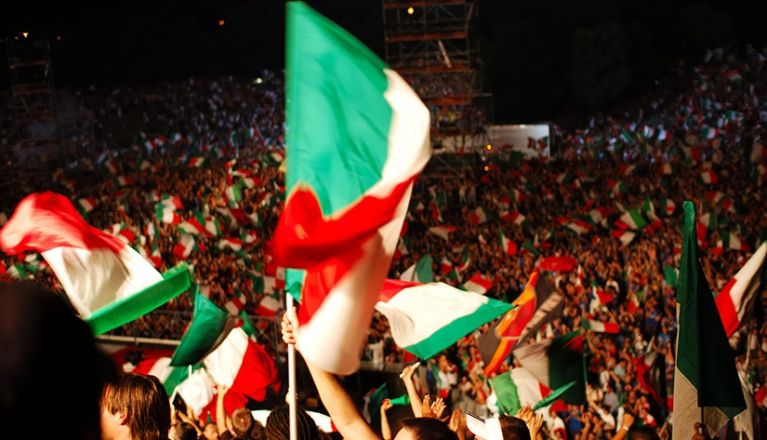-
View article
 #Economy
#EconomySouth Korea: a year after the political crisis, markets are buying the promise of stability
2025/12/17
- #Eco-trends
- 2020/02/04
- 0
-
6
Italy: what are the "Sardines" worth – 6,000, 250,000 or 25%?
The political testing ground that is Italy has accustomed us to an ever-shifting political landscape. Swimming against the prevailing anti-political tide, the grassroots “Sardines” movement has been in the media spotlight since mid-November and succeeded in influencing the most recent regional elections in Emilia-Romagna. But will the Sardines be a political sideshow or a new player in the dismantling of the institutional party system? Will they be a stabilising factor or will they add further unpredictability and instability to the political game?

6,000, 250,000 or 25%?
While it is undoubtedly too early to give a firm answer to these questions, it seems clear that the Sardines movement has filled a political vacuum and reawakened the democratic soul of a sleepy or disillusioned electorate. In mid-November, when Matteo Salvini kicked off Lega Nord’s campaign for the Emilia-Romagna regional elections, his goal was to fill the PalaDozza sports arena in Bologna, which seats 5,75 people. Little did he know how part of the population would respond, giving birth to the 6,000-strong Sardines movement. Four young people put out social media calls for a protest against Lega Nord, suggesting that a flash mob form and fill a square in Bologna with the same number of people “packed together like sardines in a tin”. The game was on and the 6,000-strong Sardines movement was born. The shoal attracted more and more sardines and the experiment was repeated in a number of cities in Italy and beyond. The Sardines’ Facebook page soon racked up more than 250,000 “likes” and almost 300,000 followers. The movement called for a mobilisation for the regional elections on 26 January. And the voters responded. The centre-left won the elections in Emilia-Romagna: 17% of the increase in the centre-left vote reportedly came from voters who had previously abstained. Thus was the centre-right steamroller – which governs 13 regions in 2020, up from a mere three in 2014 – temporarily stopped in its tracks.
The politics of “doing better” or the politics of “being against”: competing values
The Sardines appear to have succeeded in getting a disappointed progressive electorate out first into the streets and then to the polling booths. This remobilisation has been organised around a clash of values. The manifesto put forward by the Sardines contains no specific proposals (apart from the idea of a social media police to check the identity of every profile and ban hate-based content) but rather themes: solidarity, inclusion, antifascism, non-violence, respect for political opponents, and environmental protection. A political ethic intended to counter populist rhetoric. And, above all, a message: you don’t have to do anything amazing to change the world – you can change it through everyday action. The call to democratic participation is clear. The message was quickly received by the Democratic Party, which went out of its way to thank the Sardines for helping them secure victory in Emilia-Romagna. The Five Star Movement (M5S) made contact with the Sardines, no doubt recalling its beginnings, when it was able to harness the vital energy of civil society. However, unlike M5S, the Sardines have no wish to stage a rerun of the anti-political revolution. They are unconvinced by anti-establishment rhetoric. They want to push politics to do better.
Sardines shoaling off the coast…
At their first conference, scheduled for 14 and 15 March, the Sardines will be asking themselves how they can channel all this energy into an innovative political project. Will their role simply be to awaken the democratic conscience – and keep it awake – on the margins of party politics, or will they metamorphose into a political party? They are not impervious to the Democratic Party’s willingness to broaden the left-wing tent. What they decide, and how well they can continue to mobilise the electorate, will be crucial factors in the reconfiguration of Italy’s political landscape. The centre-left desperately needs to rekindle the motivation of an electorate that has either fled to M5S or abstained from voting. With Lega Nord on its own amassing 30% of voting intentions (47% with the other two centre-right parties), the Democratic Party boasts 20% of voting intentions (plus another 10% with the centre-left coalition); to govern, it has to count on M5S which, while admittedly losing momentum, still attracts 15% of the vote. The success or otherwise of its wager will determine whether Italy returns to a bipolar political system with a left-wing political offering that can counter the advancing centre-right. At the national level, the current mixed voting system, which is proportional with a 37% majority component, promotes grand pre-election coalitions and traditional divides around which they can be focused. However, this system is not set in stone and M5S is keen to return to a pure proportional system that would guarantee its ability to continue to play Left and Right off against each other. The Sardines could provide the Democratic Party with good reasons not to support this reform. That would open up a new battle line between the two forces in government.
Paola MONPERRUS-VERONI - paola.monperrus-veroni@credit-agricole-sa.fr








